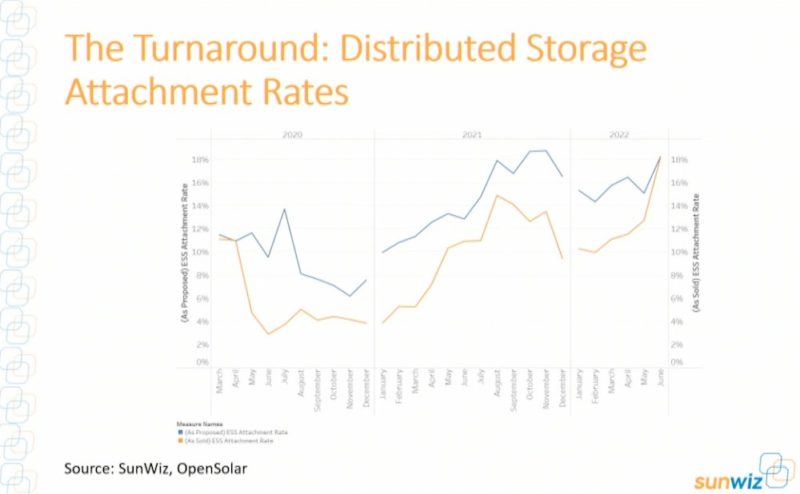
25th September 2022
Ever since Australia’s wholesale energy market started going haywire, all eyes have been on the rooftop solar and home battery market looking for an uptick in installations as consumers seek to slash their consumption from an increasingly pricey and unpredictable grid.
June now appears to have delivered just such an uptick – but with an interesting twist.
According to data and the below chart – presented by SunWiz managing director Warwick Johnston at this week’s Australian Clean Energy Summit in Sydney – batteries will be the key ingredient to the solar market rebound this year; such that there is one.
Australia is facing its first annual contraction in growth of the small-scale or rooftop solar market (0-100kW) in 2022 due to a major slowdown in installs in the first half of the year.
But Johnston says there has been a major turnaround in customer interest in installing both solar and battery storage at the same time.
That jump in the so-called “attachment rate” for batteries is illustrated in the SunWiz chart, which shows what percentage of PV systems are getting storage system attached over the past couple of years.
Based on data from Open Solar, the blue line on the chart shows what percentage of installation proposals, or quotes, are including storage, while the orange line shows what percentage of sales actually wind up including storage.
“The most interesting part for me is this uptick in June of attachment rate of batteries as sold,” Johnston told the conference, noting a “dramatic lift” to reach an attachment rate of 18% for that month.
“So essentially what we’re seeing is people are now going and saying, ‘Oh AEMO can’t keep the lights on,” Johnston says.
“They’re talking about an insurance policy coming in in three to five years called a capacity market, which may or may not work. Perhaps I should take out my own insurance policy. I’ll get storage… now seems like the right time to do it.’
“If you’re a solar company, what we’re also seeing is that the success rate on your solar proposals – it used to be that if you offered storage systems, you’d be unlikely to convert them, and so you’d probably focus your attention on PV proposals only.
“Nowadays, what we’re seeing is the reverse – people are more likely to win proposals that have storage in them than just solar alone.
“So the key trend there is… storage system conversion.”
Johnston says the number of solar quotes including battery storage that are converting into sales is currently sitting at an average of around 24%, compared to PV alone, which is sitting at about 20%.
“So if you’re not already proposing storage, then you should be. And if you’re wanting to have a look at the market trend overall, it’s that we’re going to see a lot more storage out there than has previously been the case.”
Later on at the same conference, the CEO of RACV Solar, Andy McCarthy, confirmed a similar trend – illustrated in a similar chart – for his business, which is rapidly becoming one of Australia’s biggest solar installers.

McCarthy’s chart shows the percentage of RACV Solar installations that include a battery, starting in 2020 and running up until June of this year, when just under 50% of the solar systems the company is installing were paired with a battery.
And as McCarthy explained at the conference, this uptick is not necessarily due to a sudden boost to the fundamental economics of buying a home battery.
“We used to take a lot of pride in talking customers out of installing a battery. We kind of thought it was virtuous. But the thing was, we weren’t actually asking the customer why they’re doing it.
“What we realise [now] is that, as long as you’re asking the right questions, it’s not [our] job to talk the customer out of the battery. It’s about understanding why they’re doing it.
“If they’re doing it because they want to save money, then that’s probably an honest conversation they’d need to have that it doesn’t make sense at this stage, especially with the cost of batteries recently going up.
“But there are so many other reasons, as we all know, why customers are installing storage. … [For] a customer like myself, out in regional Victoria… they might have unreliable grid electricity. I had six outages last year, significant outages. And it’s really important to understand that driver,” McCarthy said.


